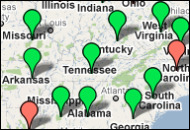
Opponents of restaurant smoking bans may argue that they threaten restaurant profits, but a new study of how a Washington State ban has affected taxable retail sales in bars and taverns suggests the opposite.
The report, published in the Center for Disease Control's "Preventing Chronic Disease," found that taxable retail sales actually went up $105 million more than expected in the two years following the state's ban. But is Washington's experience necessarily a predictor for other states?
The majority of studies in the past 15 years -- ones the report cites as using objective data and rigorous scientific methods, and as having been published in peer-reviewed scientific literature -- support the Washington State results at least as proof that there is no certain economic downside to restaurant smoking bans. The authors write, "Most of these studies have provided clear scientific evidence that there is no deleterious economic effect from smoke-free laws; several studies found positive effects, and none showed a negative effect on restaurants and bars."
Smoking is one of 20 key health measures identified for State of the USA by the Institute of Medicine.
Interactive Map: Smoking Restrictions, Percentage of Smokers by State
The CDC study acknowledges a few factors specific to Washington, which might set its experience apart from other states. First, it is possible bars raised prices to compensate for a loss of customers and that is why taxable sales increased. Second, there was a general increase in bars and taverns during the time period the study covered and that could have also affected the taxable sales (although the study says this indicates a thriving economy unaffected by the ban). And last, the state passed the ban by ballot initiative so it had popular support -- a public that was ready to patronize bars and taverns despite the ban.
But does the experience in Washington State, where15.6 percent of adults smoke, represent what would happen in states where smoking is more prevalent, such as Kentucky with 25.4 percent or West Virginia with 27.8? The interactive map below shows which states have the most and least smokers and restrictions.
According to American Nonsmokers' Rights Foundation data cited in the CDC study, 35 states and the District of Columbia have statewide restrictions on smoking. Use the map to find out if smoking is restricted in restaurants, bars and/or workplaces in your state. The red bubbles indicate that a smoking ban is in place; the green bubbles indicate that smoking is not restricted statewide. Smoking rates are included in each state's details.
View State of the USA: Smoking Restrictions and Percentage of Smokers by State in a larger map
(American Nonsmokers' Rights Foundation (PDF), Preventing Chronic Disease)
Suzette Lohmeyer is a staff writer and producer for State of the USA.
Interactive map by Anthony Calabrese, a State of the USA Web producer.